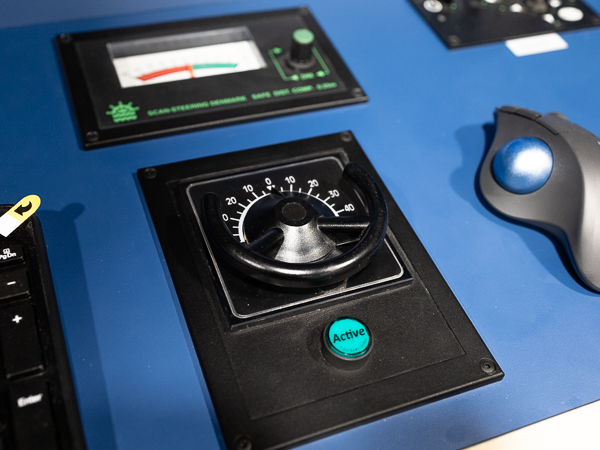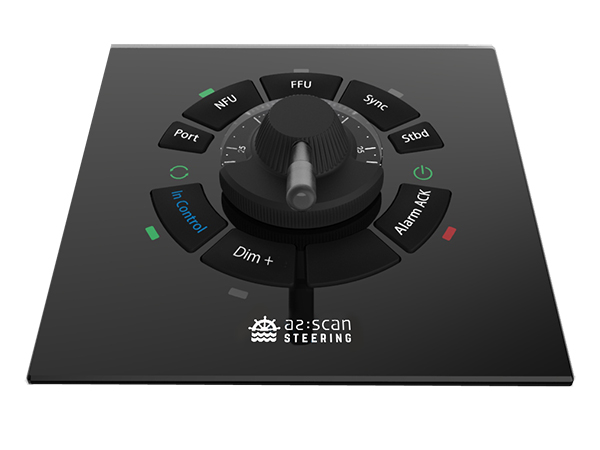Understanding the different modes of steering on a ship
Steering a large vessels, is a complex and critical task that requires precision, safety, and efficiency. Modern ships have either a rotery vane- or a RAM type steering gear. To control the steering gears the vessels are often equipped with two main steering methods: Non-Follow-Up (FNU) and Follow-Up (FU) Each method has its specific use cases, benefits, and operational characteristics, which are vital for ship operators to understand. This blog post will look into the nuances of these two steering systems, explaining how they work and when each should be used.

Follow up system mounted on the transfer- and towing vessel Skawlink.
Non-Follow-Up (NFU) steering a responsive and cost-effective solution
How does non follow up steering work
Non-Follow-Up (NFU) steering is a direct and responsive method of controlling a ship's rudder. Unlike the traditional steering wheel, which might require multiple turns to achieve significant rudder movement, the NFU system uses a lever or joystick to control rudder direction. This lever, commonly known as a "dodge lever," is designed for simplicity and immediate response:
- Three Control Positions: The NFU lever has three primary positions – center, right, and left.
- When the lever is centered, the rudder remains in its current position, regardless of the ship's movement or external conditions.
- Pushing the lever to the right causes the rudder to move to the right and will continue to do so until the lever is released or the rudder reaches its mechanical limit.
- Similarly, moving the lever to the left initiates a leftward rudder movement.
- Spring-Loaded Mechanism: Lever is spring loaded. When holding the lever over it moves the rudder in that direction. When you let go of the lever it stops. It is an intuitive and easy-to-use control for quick maneuvers. This feature is particularly useful during emergencies or when navigating in tight spaces where rapid directional changes are necessary.
Advantages of NFU Steering
NFU steering is known for being a cost-effective and robust system. It is simple to operate and doesn’t require sophisticated electronic systems, making it reliable and easier to maintain. However, while NFU steering is effective, it may not be the most comfortable for prolonged use, as the operator needs to maintain constant engagement with the lever to control the rudder.
Applications of NFU Steering
NFU steering is often used in situations where immediate rudder response is critical, such as during docking, navigating narrow channels, or when quick evasive action is required. A practical example of NFU steering can be found aboard the Norwegian ship "Skulebas," where the NFU lever is strategically mounted in the wheelhouse, allowing the crew to make quick adjustments as needed.
A example of this system can be seen on the Norwegian ship »Skulebas«, built by Hvide Sande Shipyard, where the NFU lever is mounted in the wheelhouse.

Non follow up lever mounted onboard the Norwegian vessel »Skulebas«
Follow-Up (FU) Steering: Precision and Ease of Use
How does follow up steering work
Follow-Up (FU) steering offers a more sophisticated and user-friendly approach to controlling a ship's rudder. In an FU system, the operator uses a handwheel or a lever to set a specific rudder angle. The system then automatically adjusts the rudder to the desired position and holds it there until a new command is given. Hence the name, the rudder "follows" the Follow-up lever's position. FU lever is not spring loaded and a rudder feedback is required.
-
Precise control: The FU lever allows for precise control over the rudder angle. For example, if the operator sets the lever to 20 degrees port, the rudder will move to that exact angle and remain there until another command is issued. This allows for smoother and more controlled maneuvers, which is especially beneficial during long voyages or in open waters where precise navigation is essential.
-
Integration with autopilot: One of the significant advantages of FU steering is its ability to integrate with an autopilot system. This integration allows for hands-free operation over long distances, where the autopilot maintains the ship's course, reducing the workload on the crew and minimizing the risk of human error.
Advantages of FU Steering
The FU system is known for its comfort and ease of use, particularly on long journeys or in calm seas where minimal manual intervention is required. While it comes at a higher cost compared to NFU systems, the added comfort and precision often justify the investment, especially for larger vessels or those requiring frequent long-distance travel.
Applications of FU Steering
FU steering is ideal for open water navigation where precision is key. It's particularly useful for larger vessels that need to maintain a steady course over long distances. Additionally, its integration with autopilot systems makes it an indispensable tool for modern maritime operations, allowing crews to focus on other critical tasks while the ship maintains its course autonomously.

AS SCAN steering lever on which the user can choose whether it should function as follow up or non follow up
Non follow up vs follow up
The choice between NFU and FU steering depends on the specific needs and operational context of the vessel. NFU steering is excellent for situations requiring quick, responsive control, while FU steering is ideal for precision and comfort over longer periods. Many modern ships, including those equipped by AS SCAN, offer steering systems that can switch between NFU and FU modes, providing flexibility to meet varying navigational demands.
AS SCAN Steering Solutions
AS SCAN advanced steering systemes allow users to choose between Follow-Up and Non-Follow-Up modes, depending on the situation at hand. These systems are designed with both reliability and user comfort in mind, ensuring that ship operators have the right tools to navigate safely and efficiently.
AS SCAN is a turnkey supplier of steering systems. Learn more about our single rudder and twin rudder applications.

